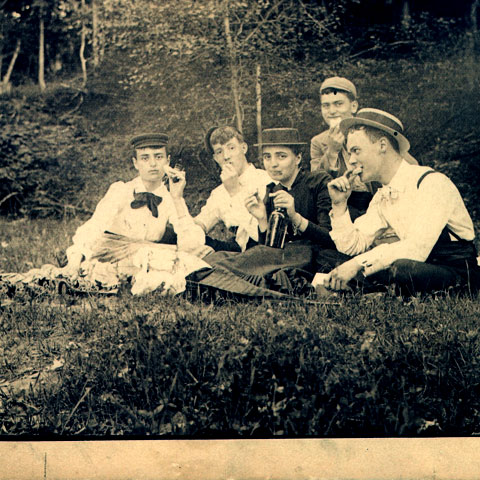 Picnicking students showcase the flat straw "boater" hat, popular for casual activities during the 1890s. From left: Katherine Durfee Hoyt, Will Conant, Augusta Durfee Flinterman, Sam Grubb, Homer Safford.
Picnicking students showcase the flat straw "boater" hat, popular for casual activities during the 1890s. From left: Katherine Durfee Hoyt, Will Conant, Augusta Durfee Flinterman, Sam Grubb, Homer Safford.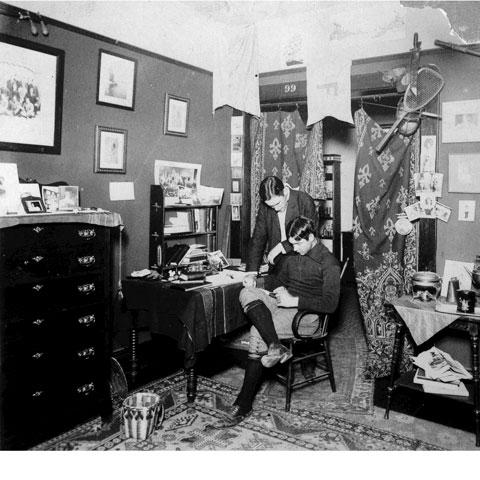 Two male students sport knickers and brogue shoes while studying. During the turn of the century, men began to abandon lavish Edwardian-style fashions, which required several changes of clothes throughout the day.
Two male students sport knickers and brogue shoes while studying. During the turn of the century, men began to abandon lavish Edwardian-style fashions, which required several changes of clothes throughout the day.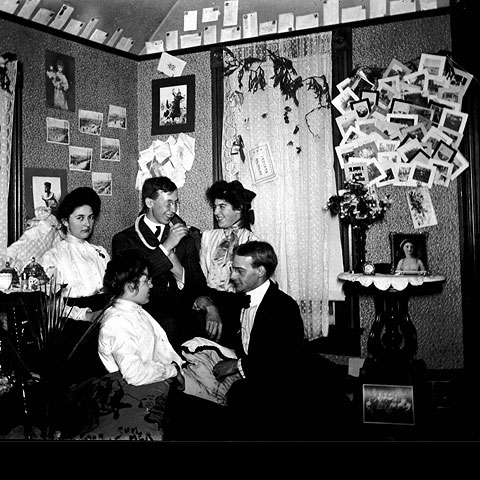 Taken in 1902, this photo displays students in more traditional attire during an off-campus outing. Men dressed with high, stiff collars while women wore "pouter pigeon" blouses and trumpet skirts.
Taken in 1902, this photo displays students in more traditional attire during an off-campus outing. Men dressed with high, stiff collars while women wore "pouter pigeon" blouses and trumpet skirts.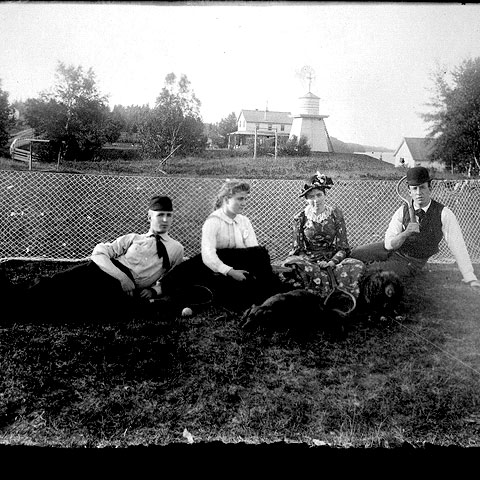 These students maintain a formal look as they take a break from their game of tennis in 1905. Even during athletic outings, women wore sportswear dresses with decorated hats, and men donned bowler hats and ties.
These students maintain a formal look as they take a break from their game of tennis in 1905. Even during athletic outings, women wore sportswear dresses with decorated hats, and men donned bowler hats and ties.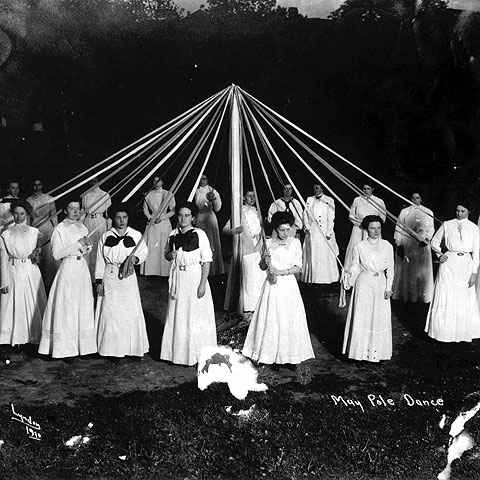 Female students perform the traditional Maypole Dance in 1918. In the early 20th century, women wore heavy, upholstered dresses – tighter in the bodice and sleeves to emphasize an hourglass figure.
Female students perform the traditional Maypole Dance in 1918. In the early 20th century, women wore heavy, upholstered dresses – tighter in the bodice and sleeves to emphasize an hourglass figure.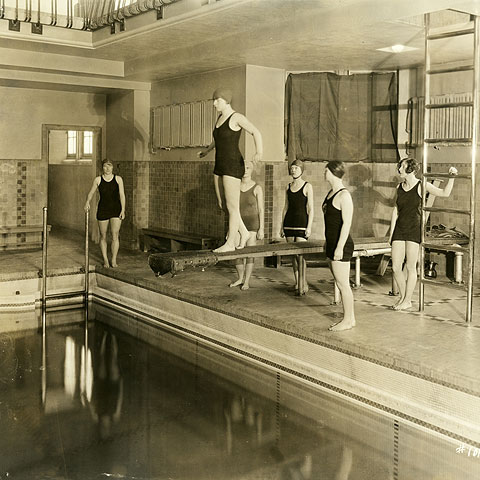 Female students swim at the Michigan Union pool wearing bathing caps and figure-hugging wool jersey suits. Compared to previous generations' bathing suits, these were considered risqué, so "modesty shorts" were built in underneath.
Female students swim at the Michigan Union pool wearing bathing caps and figure-hugging wool jersey suits. Compared to previous generations' bathing suits, these were considered risqué, so "modesty shorts" were built in underneath.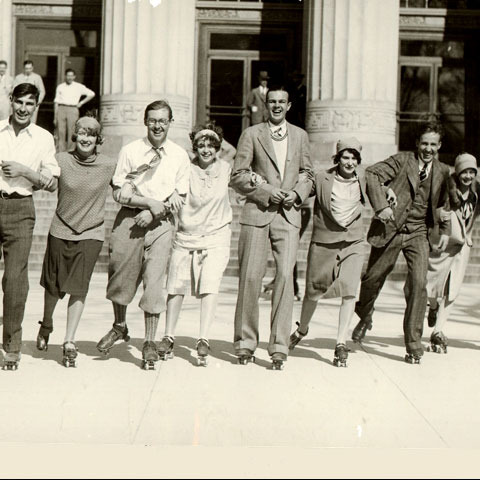 Skating in front of Angell Hall, students show off fads of the 1920s including knickerbockers for men and cloche hats for women.
Skating in front of Angell Hall, students show off fads of the 1920s including knickerbockers for men and cloche hats for women.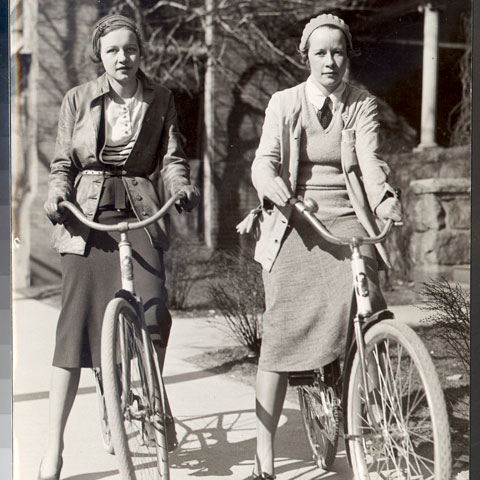 Jane Camp (left) and Barbara Lorch (right) display more popular fashions from the 1920s, such as long sweaters and knee-length skirts.
Jane Camp (left) and Barbara Lorch (right) display more popular fashions from the 1920s, such as long sweaters and knee-length skirts.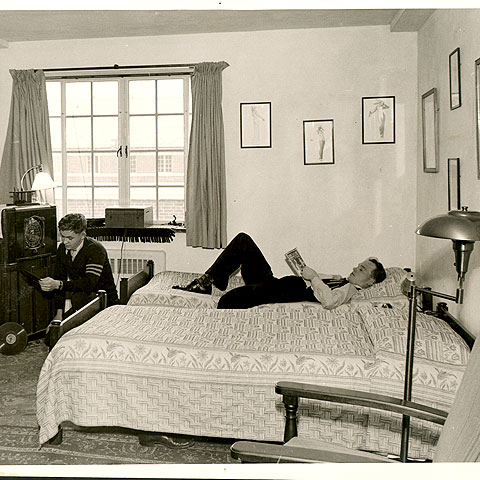 Two male students unwinding in West Quad don more casual attire, common after World War I and the 1929 Wall Street crash.
Two male students unwinding in West Quad don more casual attire, common after World War I and the 1929 Wall Street crash.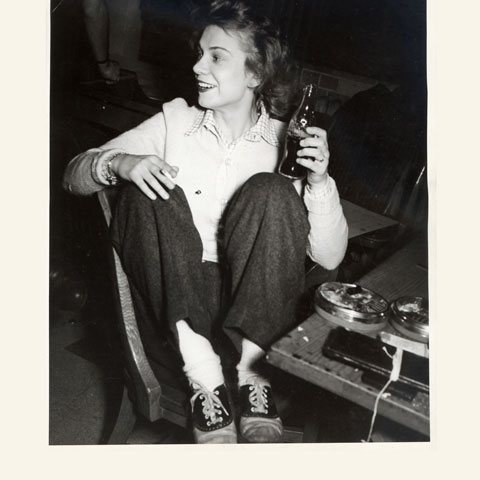 With a glass bottle of Coke in hand, a female student kicks back in her saddle shoes, popular footwear in the 1940s.
With a glass bottle of Coke in hand, a female student kicks back in her saddle shoes, popular footwear in the 1940s.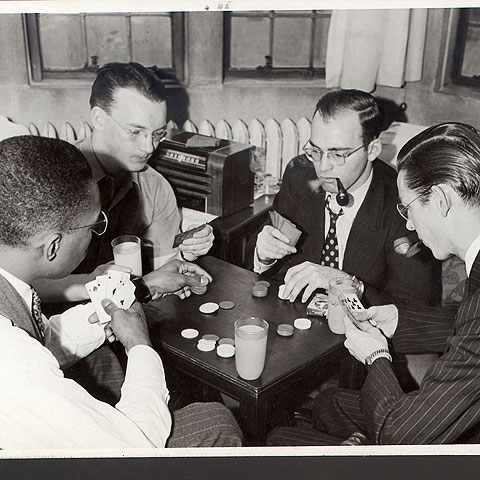 Law school students take a break from their studies to play a game of poker in 1944. Men opted to wear suits even in informal settings, but they'd include ties with geometric shapes for a livelier look.
Law school students take a break from their studies to play a game of poker in 1944. Men opted to wear suits even in informal settings, but they'd include ties with geometric shapes for a livelier look.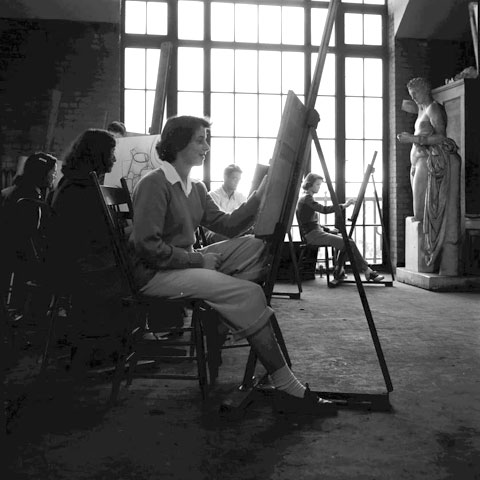 An architecture student intently sketches as she sports penny loafers and capri pants, which were both common wardrobe staples in the late 1940s.
An architecture student intently sketches as she sports penny loafers and capri pants, which were both common wardrobe staples in the late 1940s.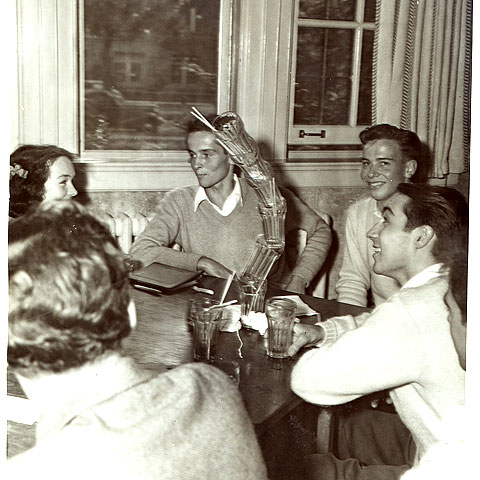 Students stack glasses at a local soda fountain. Style became more casual for both men and women in the mid-20th century.
Students stack glasses at a local soda fountain. Style became more casual for both men and women in the mid-20th century.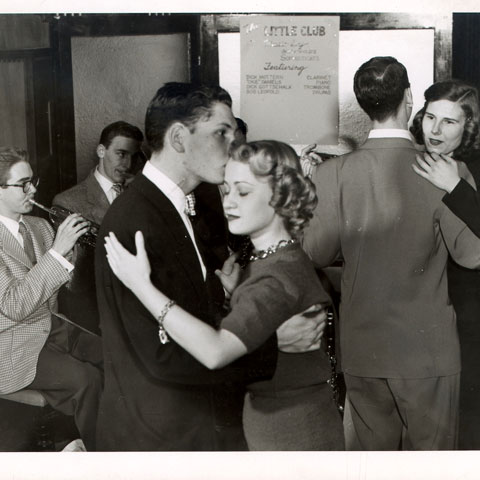 A couple dances at the Little Club in Ann Arbor while a band plays in the background. During the postwar '40s and '50s, tailored clothing and rhinestone jewelry were popular for women, as well as shorter hairstyles with large curls, which were typically set with rollers the night before.
A couple dances at the Little Club in Ann Arbor while a band plays in the background. During the postwar '40s and '50s, tailored clothing and rhinestone jewelry were popular for women, as well as shorter hairstyles with large curls, which were typically set with rollers the night before.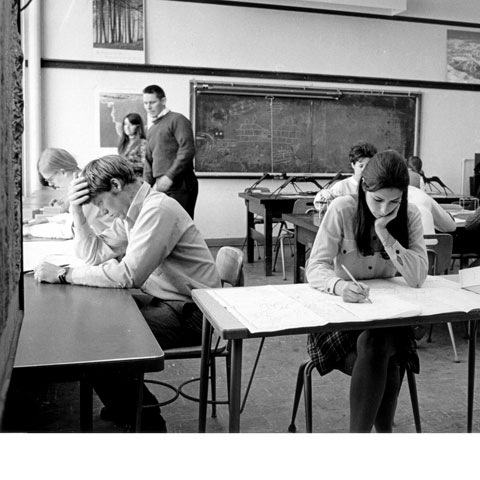 Students focus on their projects in a Michigan classroom. During the 1960s, button-down shirts were popular for both men and women, as were more relaxed pants and skirts.
Students focus on their projects in a Michigan classroom. During the 1960s, button-down shirts were popular for both men and women, as were more relaxed pants and skirts.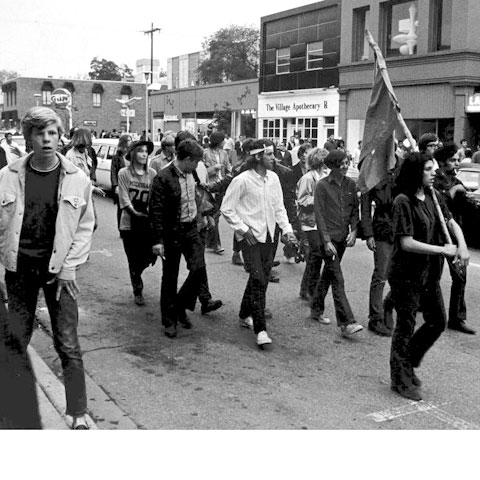 Students conduct a political march on South University Avenue in the late 1960s. In the "flower power" era, style became largely androgynous, with both women and men sporting bell-bottomed jeans and long hair.
Students conduct a political march on South University Avenue in the late 1960s. In the "flower power" era, style became largely androgynous, with both women and men sporting bell-bottomed jeans and long hair.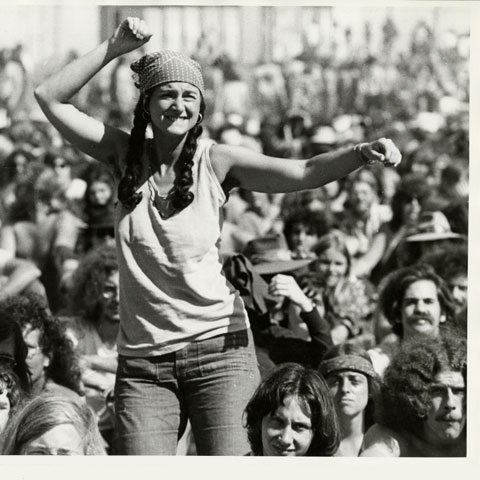 A woman dances among a crowd during a free concert in Ann Arbor during the 1970s. Bandannas were worn by men and women in lieu of more traditional hats.
A woman dances among a crowd during a free concert in Ann Arbor during the 1970s. Bandannas were worn by men and women in lieu of more traditional hats.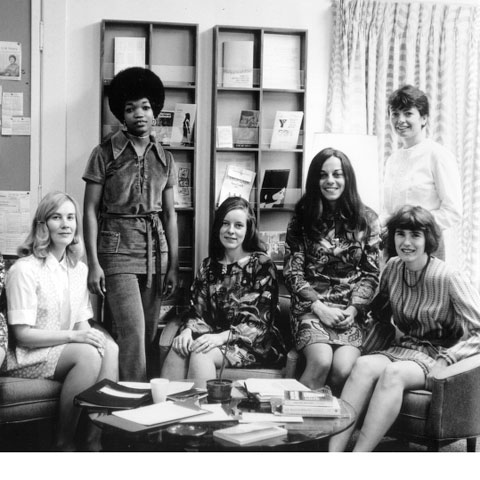 Merit scholarship winners pose for a photo in 1971. Unlike previous decades, women had the option of varying skirt lengths and often wore mid-calf-length dresses called "midis." From left in front: Marilyn Leese, Jane Wolfe, Carol Taylor, Susan Stokes and Kay Bauman. From left in back: Edith Withey and Carolyn Houser.
Merit scholarship winners pose for a photo in 1971. Unlike previous decades, women had the option of varying skirt lengths and often wore mid-calf-length dresses called "midis." From left in front: Marilyn Leese, Jane Wolfe, Carol Taylor, Susan Stokes and Kay Bauman. From left in back: Edith Withey and Carolyn Houser.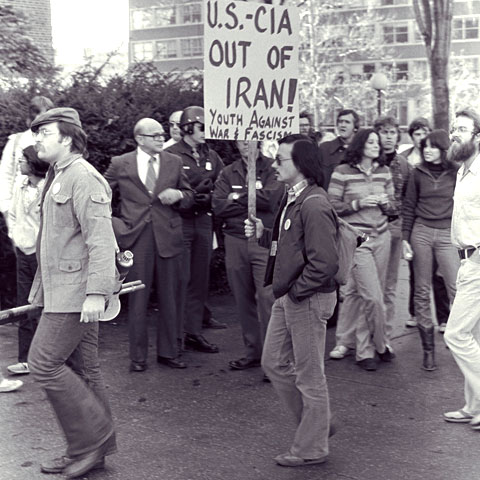 A student holds a protest sign in November 1979. Despite a 30-year gap, students today wear a similar style of jeans, tennis shoes, track jackets, and button-up shirts.
A student holds a protest sign in November 1979. Despite a 30-year gap, students today wear a similar style of jeans, tennis shoes, track jackets, and button-up shirts.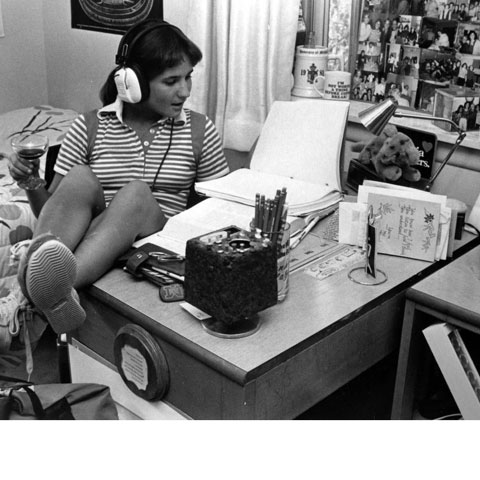 With her sneakers propped up, a student listens to music with over-sized headphones in her dorm room in 1980. Loose shirts and tight-fitting pants, jelly shoes, and shoulder pads were some of the popular trends during this time, often influenced by popular culture.
With her sneakers propped up, a student listens to music with over-sized headphones in her dorm room in 1980. Loose shirts and tight-fitting pants, jelly shoes, and shoulder pads were some of the popular trends during this time, often influenced by popular culture.
 Picnicking students showcase the flat straw "boater" hat, popular for casual activities during the 1890s. From left: Katherine Durfee Hoyt, Will Conant, Augusta Durfee Flinterman, Sam Grubb, Homer Safford.
Picnicking students showcase the flat straw "boater" hat, popular for casual activities during the 1890s. From left: Katherine Durfee Hoyt, Will Conant, Augusta Durfee Flinterman, Sam Grubb, Homer Safford. Two male students sport knickers and brogue shoes while studying. During the turn of the century, men began to abandon lavish Edwardian-style fashions, which required several changes of clothes throughout the day.
Two male students sport knickers and brogue shoes while studying. During the turn of the century, men began to abandon lavish Edwardian-style fashions, which required several changes of clothes throughout the day. Taken in 1902, this photo displays students in more traditional attire during an off-campus outing. Men dressed with high, stiff collars while women wore "pouter pigeon" blouses and trumpet skirts.
Taken in 1902, this photo displays students in more traditional attire during an off-campus outing. Men dressed with high, stiff collars while women wore "pouter pigeon" blouses and trumpet skirts. These students maintain a formal look as they take a break from their game of tennis in 1905. Even during athletic outings, women wore sportswear dresses with decorated hats, and men donned bowler hats and ties.
These students maintain a formal look as they take a break from their game of tennis in 1905. Even during athletic outings, women wore sportswear dresses with decorated hats, and men donned bowler hats and ties. Female students perform the traditional Maypole Dance in 1918. In the early 20th century, women wore heavy, upholstered dresses – tighter in the bodice and sleeves to emphasize an hourglass figure.
Female students perform the traditional Maypole Dance in 1918. In the early 20th century, women wore heavy, upholstered dresses – tighter in the bodice and sleeves to emphasize an hourglass figure. Female students swim at the Michigan Union pool wearing bathing caps and figure-hugging wool jersey suits. Compared to previous generations' bathing suits, these were considered risqué, so "modesty shorts" were built in underneath.
Female students swim at the Michigan Union pool wearing bathing caps and figure-hugging wool jersey suits. Compared to previous generations' bathing suits, these were considered risqué, so "modesty shorts" were built in underneath. Skating in front of Angell Hall, students show off fads of the 1920s including knickerbockers for men and cloche hats for women.
Skating in front of Angell Hall, students show off fads of the 1920s including knickerbockers for men and cloche hats for women. Jane Camp (left) and Barbara Lorch (right) display more popular fashions from the 1920s, such as long sweaters and knee-length skirts.
Jane Camp (left) and Barbara Lorch (right) display more popular fashions from the 1920s, such as long sweaters and knee-length skirts. Two male students unwinding in West Quad don more casual attire, common after World War I and the 1929 Wall Street crash.
Two male students unwinding in West Quad don more casual attire, common after World War I and the 1929 Wall Street crash. With a glass bottle of Coke in hand, a female student kicks back in her saddle shoes, popular footwear in the 1940s.
With a glass bottle of Coke in hand, a female student kicks back in her saddle shoes, popular footwear in the 1940s. Law school students take a break from their studies to play a game of poker in 1944. Men opted to wear suits even in informal settings, but they'd include ties with geometric shapes for a livelier look.
Law school students take a break from their studies to play a game of poker in 1944. Men opted to wear suits even in informal settings, but they'd include ties with geometric shapes for a livelier look. An architecture student intently sketches as she sports penny loafers and capri pants, which were both common wardrobe staples in the late 1940s.
An architecture student intently sketches as she sports penny loafers and capri pants, which were both common wardrobe staples in the late 1940s. Students stack glasses at a local soda fountain. Style became more casual for both men and women in the mid-20th century.
Students stack glasses at a local soda fountain. Style became more casual for both men and women in the mid-20th century. A couple dances at the Little Club in Ann Arbor while a band plays in the background. During the postwar '40s and '50s, tailored clothing and rhinestone jewelry were popular for women, as well as shorter hairstyles with large curls, which were typically set with rollers the night before.
A couple dances at the Little Club in Ann Arbor while a band plays in the background. During the postwar '40s and '50s, tailored clothing and rhinestone jewelry were popular for women, as well as shorter hairstyles with large curls, which were typically set with rollers the night before. Students focus on their projects in a Michigan classroom. During the 1960s, button-down shirts were popular for both men and women, as were more relaxed pants and skirts.
Students focus on their projects in a Michigan classroom. During the 1960s, button-down shirts were popular for both men and women, as were more relaxed pants and skirts. Students conduct a political march on South University Avenue in the late 1960s. In the "flower power" era, style became largely androgynous, with both women and men sporting bell-bottomed jeans and long hair.
Students conduct a political march on South University Avenue in the late 1960s. In the "flower power" era, style became largely androgynous, with both women and men sporting bell-bottomed jeans and long hair. A woman dances among a crowd during a free concert in Ann Arbor during the 1970s. Bandannas were worn by men and women in lieu of more traditional hats.
A woman dances among a crowd during a free concert in Ann Arbor during the 1970s. Bandannas were worn by men and women in lieu of more traditional hats. Merit scholarship winners pose for a photo in 1971. Unlike previous decades, women had the option of varying skirt lengths and often wore mid-calf-length dresses called "midis." From left in front: Marilyn Leese, Jane Wolfe, Carol Taylor, Susan Stokes and Kay Bauman. From left in back: Edith Withey and Carolyn Houser.
Merit scholarship winners pose for a photo in 1971. Unlike previous decades, women had the option of varying skirt lengths and often wore mid-calf-length dresses called "midis." From left in front: Marilyn Leese, Jane Wolfe, Carol Taylor, Susan Stokes and Kay Bauman. From left in back: Edith Withey and Carolyn Houser. A student holds a protest sign in November 1979. Despite a 30-year gap, students today wear a similar style of jeans, tennis shoes, track jackets, and button-up shirts.
A student holds a protest sign in November 1979. Despite a 30-year gap, students today wear a similar style of jeans, tennis shoes, track jackets, and button-up shirts. With her sneakers propped up, a student listens to music with over-sized headphones in her dorm room in 1980. Loose shirts and tight-fitting pants, jelly shoes, and shoulder pads were some of the popular trends during this time, often influenced by popular culture.
With her sneakers propped up, a student listens to music with over-sized headphones in her dorm room in 1980. Loose shirts and tight-fitting pants, jelly shoes, and shoulder pads were some of the popular trends during this time, often influenced by popular culture.